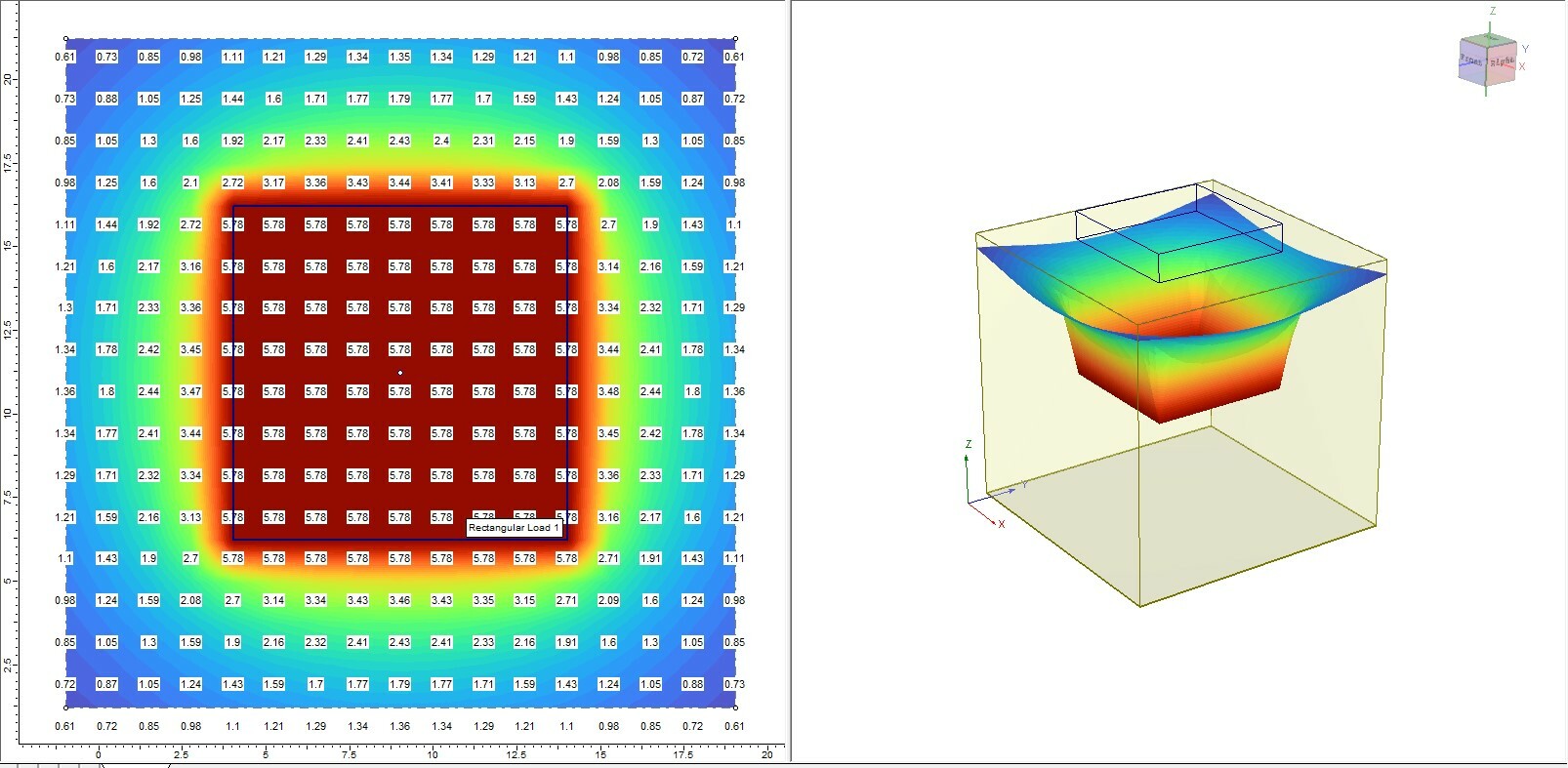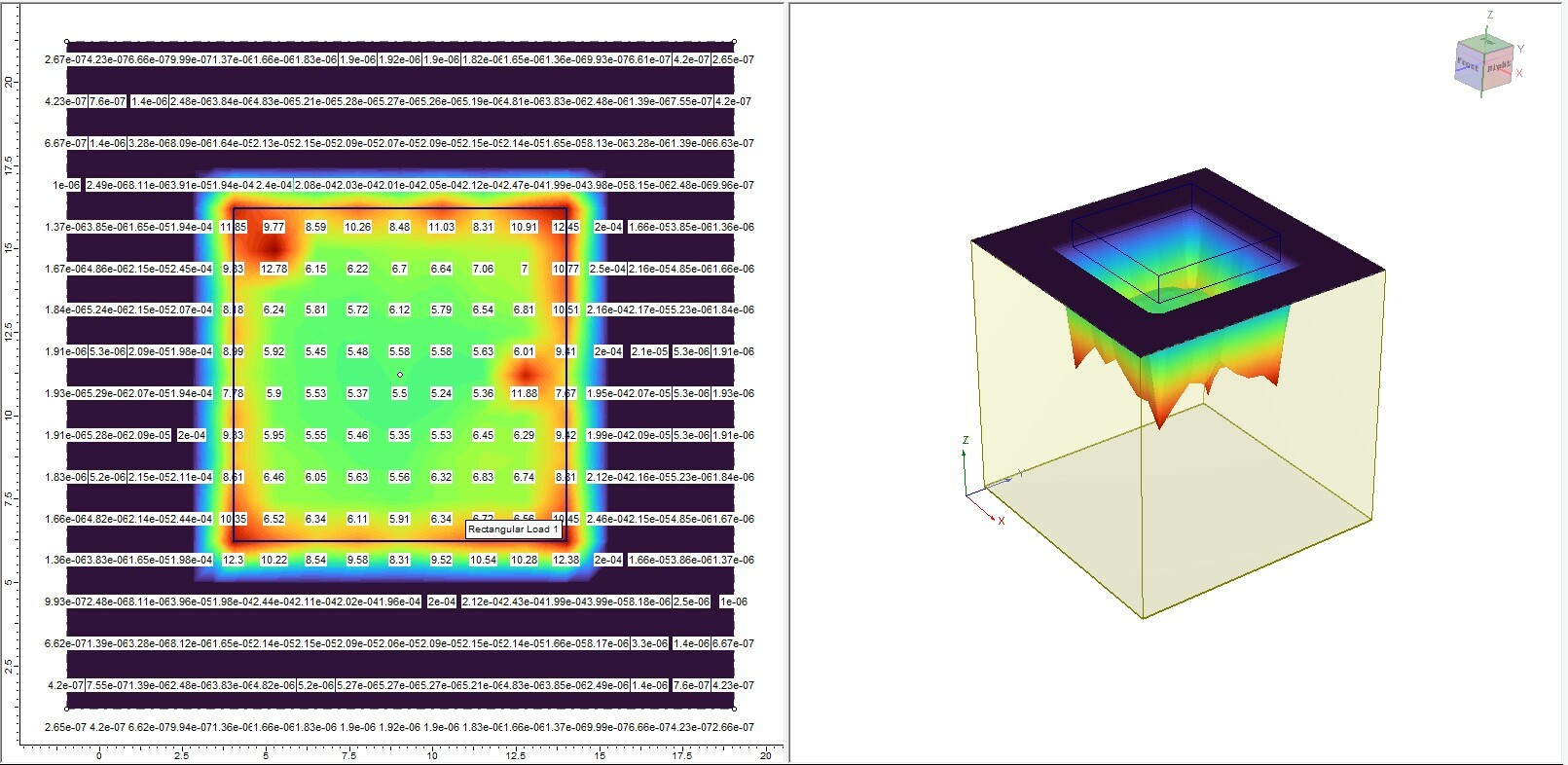Settle3 FAQs
Below you will find answers to some Frequently Asked Questions (FAQs) for Settle3. If you cannot find an answer to your question or problem after reading the FAQs:
- Try the Search feature on this Help system.
- Contact Rocscience technical support at support@rocscience.com.
FAQs
- Can the program model non-horizontal soil layers?
Although Settle3 does not allow for explicit 3-dimensional modeling of non-horizontal soil layers, it is possible to analyze variable soil profiles, if the analysis is limited to a single point query, and you are using the Boussinesq stress computation method. In this case, you simply have to modify the soil profile in the Soil Layers dialog, for each point query location, and re-run the analysis. Please refer to our theory manual on non-horizontal surface layers as well as extruded section for more information on how to model soil with varying surface elevation soil model. - Is it possible to model loads with a rigid foundation?
Settle3 allows you to model loads with a rigid foundation. However, it is not possible to use rigid loads with time dependent consolidation. Only elastic settlement or long term consolidation can be modeled with rigid loading. - When to use flexible load vs rigid loads?
You can refer to Modelling page for more information on this. - How does rigid load work and why do I see higher stresses around the edges of the loading region?
Rigid load will try to restrain uniform/planar settlement which is then used to calculate the loading stresses. Below shows an example of 10 kPa load applied as rigid load on soil medium and its settlement contour plot:
However, if you look at the stress distribution, you'll see that around the edges they're higher in values (some grid points higher than 10 kPa applied).
This is due to the fact at the edges, the stress required to maintain uniform displacement is higher than the stress required near the middle of the middle.
As an analogy, when you have a rigid plate and trying to push down to some medium, you'll naturally try to apply more loads at the edges to keep the plate in uniform shape, so it's bit similar concept how the program is demonstrating this behavior.
- How does Settle3 handle rebound / heave during unloading when immediate settlement is not used?
With respect to rebound for a non-linear material, when unloading occurs, strain is calculated using Cr instead of Cc. Cr is generally less than Cc so you will get less displacement during unloading than you would for loading. The same is true for the secondary consolidation. When unloading, Car is used instead of Ca. - Subgrade modulus reaction is yielding negative results. What's happening?
In the model, you may have excavation or other elements (such as rigid loads) that is causing the total settlement to be in negative value. According to our theory manual on subgrade modulus reaction, the modulus is calculated based on loading stress without excavation over total settlement. Thus, if the applied load after excavation is not causing the total settlement to be in the positive value, Settle3 will take the applied loading stress over total settlement, resulting in negative value.
Couple of tips related to this issue would be to:
a) Check the final settlement and see if loading stress is sufficient to counter any rebound or heave effects in the model.
b) You can use the reference staging option (reference stage at excavation stage) to neglect the effect of excavation in the subgrade modulus results. However, note that if the loads are still not large in magnitude to offset the heaving effects, subgrade modulus will still be in negative value. - Poisson's ratio does not seem to affect the analysis results, why?
Poisson's ratio is only applicable if you are using mean 3D stress, multiple layer or Westergaard stress computation, or rigid loading. See the Soil Properties topic for more information. - Different staging factor for soil materials does not seem to change the results for constant load in different stages for immediate settlement. Why?
Settlement is calculated based on the change in the stresses. If the load is constant throughout the stages, the immediate settlement at the staged loading will compute the settlement and this will be the settlement shown in the other stages as well. If you are interested in seeing different settlement with the staged factor for immediate settlement, we can recommend you to remove the load and re-apply a load in different stages to see the staged factor results. - How does Settle3 compute pore pressure when material is excavated below the water table?
When an excavation is added that extends below the water table, the water table is locally dropped to the bottom of the excavation. This is to ensure that the excavation is dry and not full of water. Query points inside the excavation will see a drop in pore water pressure. Query points outside of the excavation are unaffected by the drop in the water table.
This approach tends to overestimate the settlement (it gives a conservative answer), compared with what would be observed for a true three-dimensional groundwater analysis, since this approach does not account for horizontal water flow from areas of higher pressure (outside of the excavation) to areas of lower pressure (under the excavation).
- How does a time point query work for staged loading?
A Time Point Query only computes the time based on the current load state, at the time point stage. If the load changes after the time point stage (i.e. if loads are added or removed) the time point is not aware of the change in load state after the time point stage. Therefore if you have staged loading, you must add the time point at the final loading stage that you wish to consider. - When should I consider immediate settlement?
Click here for an article which discusses when to use immediate settlement, primary consolidation or both. - Secondary settlement is yielding zero results for the soil that is dry / when I remove the groundwater. Why is that?
Secondary settlement is calculated based on a primary consolidation settlement in Settle3. Based on the project settings, when the user-defined percentage of primary consolidation is reached, then secondary settlement is calculated. When the groundwater is removed or is not assigned to the soil material, then the soil is considered to be in fully drained / dry condition. This means that we have a completely dry consolidation settlement and there will be no change in vertical strain along time for secondary settlement.
- What is happening to my model when I have no ground water, or piezometric line at bottom of the soil model with primary consolidation analysis option on?
- My program crashes when I open the file. What should I do?
Sometimes when Settle3 file is simultaneously edited in network shared drive, this may corrupt the results which causes Settle3 file to close upon opening. Try to first check whether the extension of the Settle3 file is .s3z or .s3d. If the latter, copy the .s3d file somewhere to an empty folder and attempt to open it. If .s3z, rename it to .zip first, then extract the contents, then move/copy .s3d to another empty folder and try to open it. - RSLog boreholes from previous versions are not visible, show should I do?
Follow step 13 to create the .s3d file. Click on the RSLog boreholes and Edit with notepad. Replace all words with "ILOG Borehole" with "RSLog Borehole" and you should be able to see all the boreholes with its information correctly.
If the immediate settlement option on, you'll see a immediate settlement of the soil, in dry state. However, if the users have enabled primary consolidation, then they'll see primary consolidation settlement contribute to the soil model, even in dry state. The settlement on how this is calculated is explained more in details in our Theory Manual Section 3.2. If linear method is used:

If non-linear method is used:

Note that in our theory manual we explain that consolidation settlement is pore water pressure dissipation over time. However, since the model doesn't have time associated also piezometric line is not on top of the soil, it's undergoing fully drained analysis, and the settlement will show the 'infinite time' settlement in dry condition.
Also, this happens because we assume that the pore pressure is zero above ground water, so as long as there is a load, the pore pressure will increase with the same amount of the stress increase. And then there will be consolidation. This is unfortunately not realistic and can cause some confusion. In order to account for this correctly, you should have create another soil above the ground water that does not have consolidation activated.